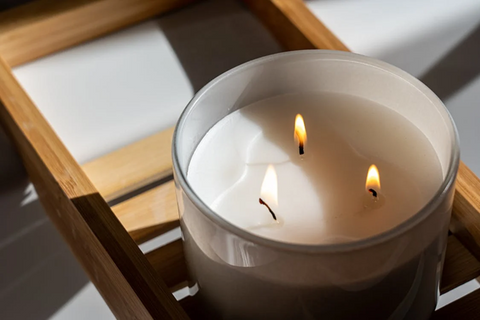There's nothing quite like the frustration of a candle that burns down the middle, leaving a stubborn ring of unused wax clinging to the jar. It's not just a waste; it can be a real hazard, too.
Uneven burning can lead to a wick that's too long, a flame that's too high, and even a jar that's dangerously hot. Plus, nobody wants to deal with customer complaints about their candles burning away too quickly.
If you're tired of tunnelling and ready for that perfect, even melt, this quick guide's got you covered.

What is tunnelling?
Tunnelling in candles occurs when only the centre of the wax near the wick melts and burns down, creating a narrow tunnel-like hole. This common issue can be frustrating as it wastes a significant amount of wax and shortens the candle's lifespan and, in the perspective of a customer, can reflect a poor quality candle despite that being far from the truth!
Tunnelling typically happens when the candle isn't allowed (or able) to melt across the entire surface on the first burn, setting a memory ring that leads to uneven future burns. Factors contributing to tunnelling include incorrect wick size, poor quality wax, or draughty burning conditions. Understanding and addressing these causes can help ensure a clean, even burn for your candles.
How to stop a candle from tunnelling
Now, let’s get you up to speed on how to make a candle burn evenly. To ensure yours burn beautifully every time, here are some top tips:
Tip 1: It all starts with the right size wick
We can’t stress this enough: As tedious as it may seem, testing is key in candle-making. Start with the suggested wick size for your chosen wax and container size as a guideline, but be prepared to adjust. For instance, if a candle with an HTP 105 wick tunnels in a 20cl base, consider trying an HTP 126 wick. The right wick ensures optimal burn performance, setting the stage for a perfectly performing product!
Tip 2: Focus on the first burn
This is when it all comes together for the lucky new owner of your candles. Remember to include a burn time on the label (usually no more than 4 hours), so your customer knows not to surpass this timeframe. Heads up: It’s actually a myth that a candle needs to achieve a full melt pool on the first burn, however, a slight rim of un-melted wax is totally fine, so long as the burn pool is even in all directions. This little detail helps prevent memory rings, paving the way for consistent burns later on.
Tip 3: Trim the wick to the right length
Keep your wick trimmed to about 1/4 inch before each burn. A shorter wick promotes a controlled flame, reducing the risk of tunnelling and ensuring an even melt pool. While this length of wick is usually failsafe, you may have to undertake a little testing to get this right.
Tip 4: Use a candle snuffer to extinguish your candles
A candle snuffer helps prevent excess smoke when extinguishing a candle but did you know, it can also prevent the wick from becoming crushed if your customers are prone to using their fingers to snuff out the last little ember on the wick - vital for ensuring the wick integrity is retained. This is especially useful for larger candles. Candle giant Diptyque has added a touch of luxury to candle care with their range of snuffers. It's a stylish way to extinguish candles, enhancing the overall experience.
Consider offering similar accessories in your range; it’s a small addition that can prolong the life of your candles, elevate their perceived value and offer customers a luxe experience.
Tip 5: Avoid drafts
Burning your candle away from drafts ensures the flame remains steady and doesn't cause the wax to melt unevenly. This is basic candle safety knowledge, but it’s worth knowing it also affects candle quality.
Benefits of an even candle burn
Achieving an even burn for your candles is more than just avoiding the dreaded tunnelling effect; it's about enhancing the overall candle experience. Here are some key benefits to nailing that burn:
✓ Longevity
An even burn extends the life of your candle, ensuring customers get every penny's worth.
✓ Consistency
A uniform melt pool allows for a steady fragrance release, filling the room with a balanced aroma.
✓ Safety
Maintaining an even burn allows you to minimise the risk of high flames or excess soot, making your candles safer to enjoy.
✓ Aesthetics
Candles that burn evenly maintain their beauty, looking just as appealing on the last burn as they did on the first.
Here’s to an even burn, every single time
We've navigated the pitfalls of candle tunnelling and shared key tips to ensure an even burn. From the initial burn to wick trimming, these strategies not only enhance the longevity of your candles but also amplify their fragrance and aesthetic appeal.
Now you’ve learned how to make a candle burn evenly, it’s time to create, sell, and share this wisdom with your customers. Eager for more insights? Head over to our Tips & Advice page.

2 comments
Brilliant advice as always x
A Wee Thank You
Got my first little order from you yesterday. Very impressed with the quality of goods and speed of service.
I will be back.
Thanks again
Cheers
Heather
———
NI Candle Supplies LTD replied:
You’re very welcome Heather, thanks for your support!